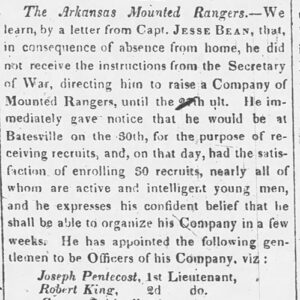calsfoundation@cals.org
Bean's Rangers
Captain Jesse Bean’s Ranger Company was one of six companies of mounted militia authorized by Congress in 1832. Led by a member of a prominent Arkansas family, the company formed a part of the first mounted battalion in the U.S. Army for seventeen years. Its actions are representative of the militarization of Arkansas’s western border and the area beyond during the territorial period.
Influenced in 1815 by a need for economy and a deep-rooted fear of standing armies, Congress had eliminated cavalry, considered by some to be a uniformed elite, from the army. However, the Black Hawk War in Illinois and Wisconsin reminded legislators of the utility of cavalry, and, on June 15, 1832, Congress authorized President Andrew Jackson to raise a mounted ranger battalion of one-year volunteers. Jackson commissioned politician-soldier Henry Dodge to command the battalion, but the war ended before it could join the fighting. Subsequently, three companies were posted to the northwestern frontier, and three companies—including Bean’s Rangers—were ordered to Fort Gibson in the Indian Territory near present-day Muskogee, Oklahoma.
Jesse Bean was an accomplished woodsman and one of only two company officers with any military experience when he was commissioned in the Ranger Battalion. According to the July 18, 1832, issue of the Arkansas Gazette, Bean had fought at New Orleans, Louisiana, and in the Indian wars in Florida. His father Robert, a Revolutionary War veteran, was an early settler at Batesville (Independence County) and speaker in Arkansas’s territorial legislature. His family’s standing in Arkansas and long association with Jackson probably improved Bean’s chances for selection as a company commander. After filling out his company in Batesville, Bean was ordered west on August 27, 1832, and reached Fort Gibson on September 24, 1832.
Established by Western Department Order 20, dated March 6, 1824, Fort Gibson was sited “near the Arkansas Osage, who would thus be under stricter surveillance of the troops.” Colonel Matthew Arbuckle, commander of the Seventh Infantry Regiment, which was previously based in Fort Smith (Sebastian County), began work on the post in April 1824 and occupied it in mid-1827. Arbuckle still commanded the fort when Bean’s Rangers arrived, and, within two weeks, he ordered Bean to scout northwest to a point near modern-day Tulsa, Oklahoma; ride south through a wooded area called Cross Timbers; and return to the fort by way of the north fork of the Canadian River. Bean was also to invite tribal leaders to gather at the fort in the spring for negotiations.
On October 8, 1832, just after Bean had departed, government commissioner Henry L. Ellsworth arrived at Fort Gibson. His mission, which Arbuckle had partially anticipated with his instructions to Bean, was to seek a settlement between the nearby Plains Indians and the newly resettled eastern tribes. To aid his mission, Arbuckle sent Ellsworth, accompanied by authors Washington Irving and Charles Latrobe, to join Bean’s command.
Ellsworth and both authors later wrote about their time riding with the Rangers. Ellsworth, as the government’s commissioner, wanted a force to impress the tribes. He judged the Rangers to be good farmers and citizens, but he believed that their egalitarian behavior and the penny-pinching character of the expedition created too poor an impression to overawe the Native Americans. Latrobe found the Rangers to be a mix of solid citizens and adventurous youths leavened by a few “neer-do-wells,” and Irving invoked the image of Robin Hood to capture the lack of military discipline and picnic-like quality of the Rangers’ camp.
In December 1832, about a month after Bean’s Rangers returned to Fort Gibson to join two other Ranger companies in winter quarters nearby, Congress received Secretary of War Lewis Cass’s judgment that the Rangers’ short enlistments wasted hard-won experience and left little time to perform tasks effectively, making them ineffective and uneconomical. While such formations were necessary, he reported that regular cavalry was “fully competent to the discharge of all the duties required of mounted rangers.” On March 2, 1833, Congress responded with an act that “in lieu of the battalion of mounted rangers…established a regiment of dragoons.”
In May 1833, the Rangers saw their last service in the field when Arbuckle ordered Lieutenant Colonel James B. Many to take the Ranger companies and two infantry companies to explore and show the flag in the area west of the fort between the Canadian and Red rivers. Somewhere between the headwaters of the Blue River and the Washita River in June 1833, a band of Indians captured Ranger George Abbay, who was later killed. Many pursued the Indians without success and returned to Fort Gibson in early July. Bean’s company was discharged in August 1833, but he stayed and accepted a commission in the new First Dragoons. He held the position until May 31, 1835, when he resigned from service.
For additional information:
Agnew, Brad. Fort Gibson: Terminal on the Trail of Tears. Norman: University of Oklahoma Press, 1980.
Ellsworth, Henry Leavitt. Washington Irving on the Prairie; or, a Narrative of a Tour of the Southwest in the Year 1832.Edited by Stanley T. Williams and Barbara D. Simison. New York: American Book Company, 1937.
Foreman, Grant. Pioneer Days in the Early Southwest. Lincoln: University of Nebraska Press, 1994.
Irving, Washington. A Tour on the Prairies. Philadelphia: Carey, Lea & Blanchard, 1835. Online at http://etext.virginia.edu/toc/modeng/public/IrvTour.html (accessed February 8, 2022).
Latrobe, Charles Joseph. The Rambler in North America, 1832–1833. 2 vols. New York: Harper & Brothers, 1835.
Ryan, Harold W. “Matthew Arbuckle Comes to Fort Smith.” Arkansas Historical Quarterly 19 (Winter 1960): 287–292.
Wayland, Paul T. “Captain Bean’s Rangers.” Independence County Chronicle 1 (April 1960): 35–38.
Williams, Stanley T., and Barbara D. Simison. “A Journey through Oklahoma in 1832: A Letter from Henry L. Ellsworth to Professor Benjamin Silliman.” Mississippi Valley Historical Review 29.3 (1942): 387–393.
Young, Otis E. “The United States Mounted Ranger Battalion, 1832–1833.” Mississippi Valley Historical Review 41.3 (1954): 453–470.
Larry A. Grant
North Charleston, South Carolina
 Bean's Rangers
Bean's Rangers 




Comments
No comments on this entry yet.